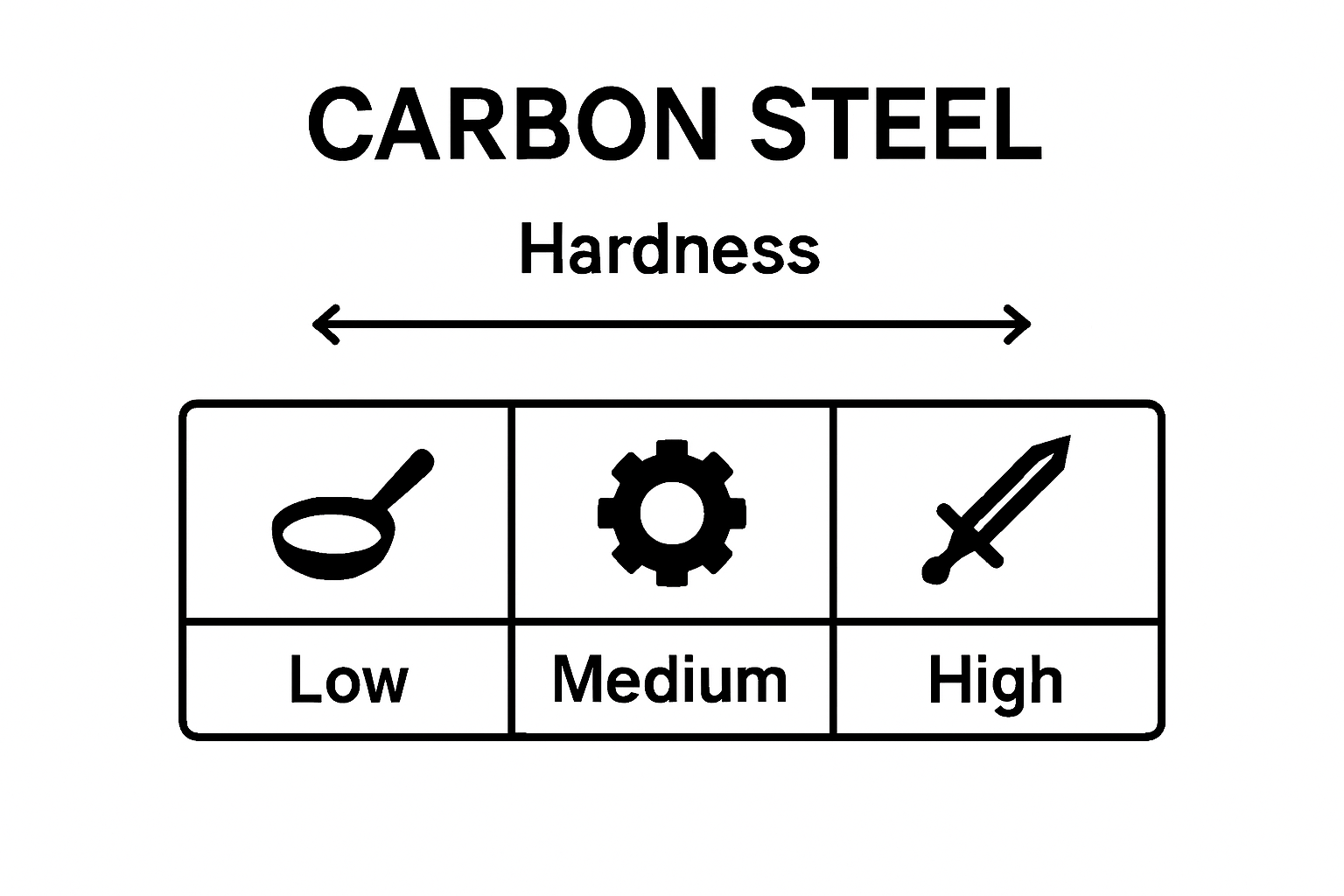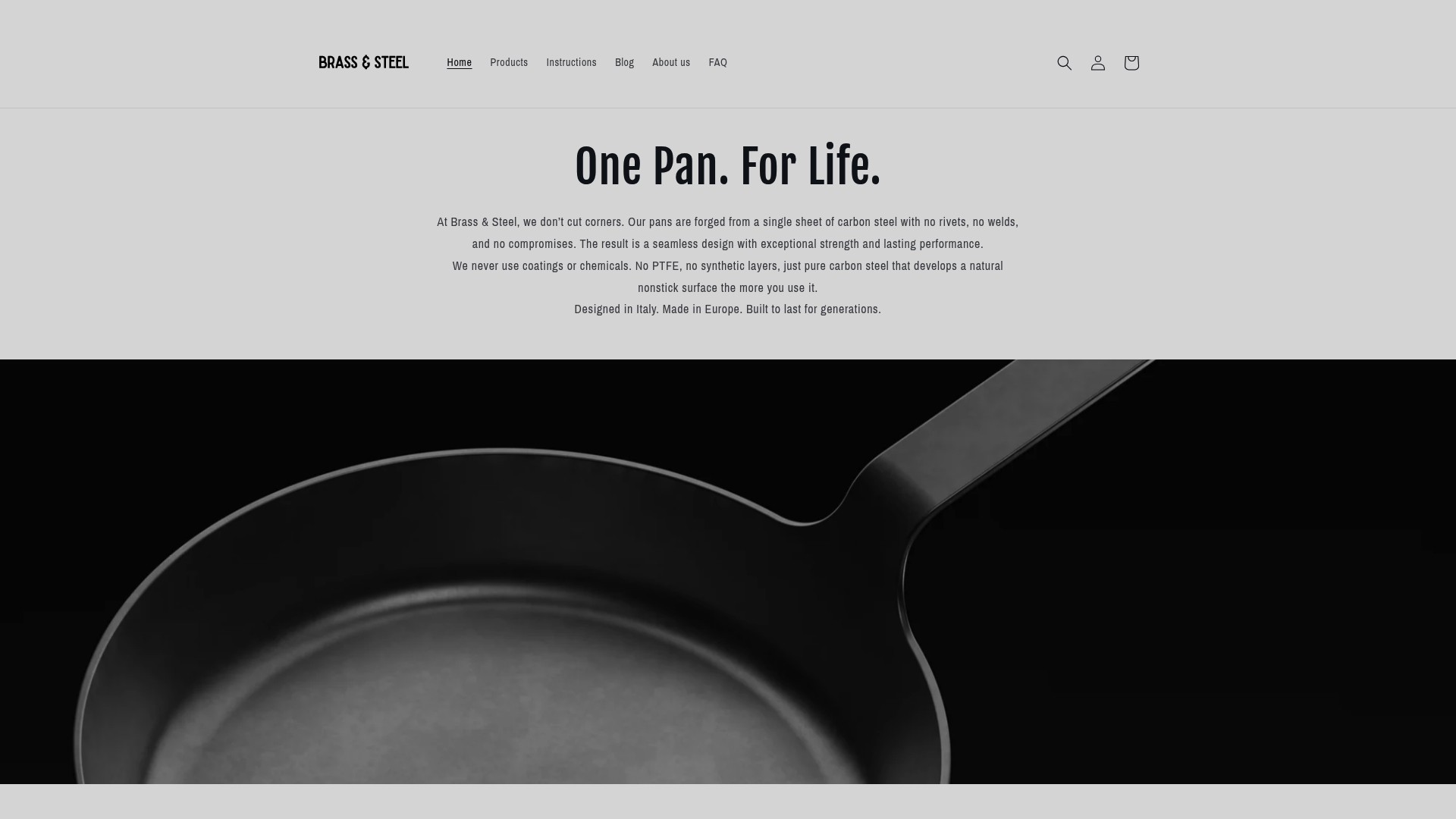
What is Carbon Steel Maintenance? Understanding its Importance
Share
Carbon steel is found everywhere, from professional kitchens to massive engineering projects. Many people think its main appeal comes from its strength or sharp edges but that only scratches the surface. Even a tiny change in carbon content—sometimes as low as 0.05%—can wildly transform its hardness, flexibility, and heat conduction. Surprising, right? The real secret is that carbon steel’s performance all depends on how well you care for it and that maintenance can make the difference between a rusty relic and a tool that outlasts generations.
Table of Contents
- Defining Carbon Steel And Its Unique Properties
- The Significance Of Maintaining Carbon Steel Cookware
- Common Challenges In Carbon Steel Maintenance
- Effective Techniques For Caring For Carbon Steel
- Real-World Applications Of Well-Maintained Carbon Steel
Quick Summary
| Takeaway | Explanation |
|---|---|
| Understand carbon steel properties | Composed mainly of iron and carbon, it offers significant strength and durability depending on carbon content. |
| Maintain cookware for longevity | Proper care prevents rust and maintains non-stick qualities, ensuring the cookware performs well over time. |
| Control moisture to avoid corrosion | Environmental factors like humidity can lead to degradation; meticulous drying and storage practices are crucial. |
| Recognise challenges in maintenance | Factors such as cleaning techniques and chemical interactions can impact carbon steel cookware’s lifespan and performance. |
| Emphasise regular inspections | Routine checks and contaminant removal extend the functional life and safety of carbon steel items in various applications. |
Defining Carbon Steel and Its Unique Properties
Carbon steel represents a sophisticated alloy of iron and carbon, transforming basic metallic properties into a material with remarkable strength and versatility. Learn more about the unique characteristics of carbon steel and understand why it has become a cornerstone in various industrial and culinary applications.
The Fundamental Composition
At its core, carbon steel is defined by its carbon content, which typically ranges between 0.05% and 2.1%. According to research from the American Iron and Steel Institute, this precise carbon concentration determines the metal’s mechanical properties, fundamentally altering its performance characteristics.
The carbon composition influences several critical attributes:
- Increased hardness and strength
- Enhanced durability
- Improved heat conductivity
- Variable malleability depending on carbon percentage
Metallurgical Characteristics
Carbon steel’s unique properties emerge from its microstructure. As carbon atoms integrate into the iron lattice, they create interstitial solid solutions that dramatically transform the metal’s mechanical behaviour.
The following table clarifies the differences between the three main categories of carbon steel based on their carbon content and properties.
| Type of Carbon Steel | Carbon Content | Key Properties |
|---|---|---|
| Low carbon steel | 0.05-0.25% | Soft, highly ductile, easily formed |
| Medium carbon steel | 0.25-0.6% | Balanced strength and flexibility |
| High carbon steel | 0.6-2.1% | Extremely hard, less ductile |

- Low carbon steel (0.05-0.25% carbon): Softer, more ductile, easily formed
- Medium carbon steel (0.25-0.6% carbon): Balanced strength and flexibility
- High carbon steel (0.6-2.1% carbon): Extremely hard, less ductile
In culinary contexts, this metallurgical complexity translates into cookware with exceptional heat distribution, durability, and performance. Carbon steel pans, for instance, develop a natural nonstick seasoning layer through repeated use, making them prized among professional chefs and cooking enthusiasts.
Understanding carbon steel’s composition is not just about technical specifications but appreciating a material that bridges engineering precision with practical functionality.
The Significance of Maintaining Carbon Steel Cookware
Carbon steel cookware demands thoughtful maintenance to preserve its exceptional performance and longevity. Explore advanced techniques for carbon steel cooking and understand why consistent care transforms these culinary tools from mere kitchen implements into generational cooking companions.
Protection Against Degradation
Maintenance is not merely a recommendation but a critical process for carbon steel cookware. According to nutrition expert Lindsay Malone, proper care ensures the cookware remains safe, functional, and free from potential contamination.
The primary reasons for rigorous maintenance include:
- Preventing rust formation
- Maintaining natural non-stick properties
- Preserving heat distribution capabilities
- Extending the cookware’s operational lifespan
Culinary Performance and Health Considerations
Proper maintenance of carbon steel cookware goes beyond aesthetic preservation. The seasoning process creates a protective layer that not only prevents rust but also enhances cooking performance. This natural coating develops through consistent use and careful treatment, transforming the cooking surface into a smooth, near-nonstick environment.
Key health benefits of maintaining carbon steel cookware include:
- Eliminating potential metal contamination
- Reducing the risk of surface degradation
- Ensuring consistent cooking temperatures
- Preventing harmful chemical interactions with food
Carbon steel maintenance represents a delicate balance between scientific understanding and culinary craftsmanship. By investing time in proper care, home cooks and professional chefs alike can ensure their cookware delivers exceptional performance for years, if not decades, of culinary exploration.

Common Challenges in Carbon Steel Maintenance
Carbon steel maintenance presents unique challenges that require strategic understanding and proactive management. Discover strategies for managing acidic foods in carbon steel cookware to protect your culinary investment and ensure optimal performance.
Corrosion and Oxidation Risks
Corrosion represents the most significant threat to carbon steel’s structural integrity. According to industrial research on metal degradation, seven critical factors contribute to potential surface breakdown:
- Humidity exposure
- Temperature fluctuations
- Surface contamination
- Inappropriate cleaning techniques
- Prolonged moisture contact
- Chemical interactions
- Mechanical stress
Environmental and Handling Vulnerabilities
Carbon steel’s sensitivity to environmental conditions demands meticulous care. The metal’s inherent properties make it susceptible to rapid degradation when exposed to moisture, acidic substances, or inconsistent temperatures. Professional chefs and home cooks must develop a nuanced understanding of these vulnerabilities to prevent premature cookware deterioration.
This table summarises the most common challenges encountered during the maintenance of carbon steel cookware and their potential effects.
| Challenge | Description | Potential Effect on Cookware |
|---|---|---|
| Humidity exposure | Contact with moist air or water | Accelerated rust formation |
| Temperature fluctuations | Changes from hot to cold or vice versa | Warping and surface damage |
| Surface contamination | Build-up of residues or particulate matter | Dulling, pitting, contamination |
| Inappropriate cleaning techniques | Use of harsh agents or incorrect tools | Surface degradation, loss of coating |
| Prolonged moisture contact | Cooking or storage without thorough drying | Persistent rust, structural weakness |
| Chemical interactions | Exposure to acidic/salty foods or cleaning agents | Corrosion, pitting, surface changes |
| Mechanical stress | Repeated impact or rough handling | Deformation, cracks |
Key environmental challenges include:
- Rapid rust formation in high humidity environments
- Surface pitting from salt and acidic ingredient exposure
- Potential warping under extreme temperature changes
- Potential chemical reactions with certain cleaning agents
Understanding these challenges transforms maintenance from a routine task into a sophisticated preservation strategy. By recognizing the complex interactions between carbon steel and its environment, users can implement targeted protection methods that extend their cookware’s functional lifespan and maintain its superior cooking performance.
Effective Techniques for Caring for Carbon Steel
Carbon steel maintenance requires precision, understanding, and systematic care to preserve its exceptional culinary performance. Learn how to expertly re-season your carbon steel pan and transform routine maintenance into an art form that extends your cookware’s functional lifespan.
Protective Preservation Strategies
According to preservation techniques from the U.S. National Park Service, effective carbon steel maintenance revolves around proactive protection and consistent monitoring. Professional conservationists emphasize three fundamental principles:
- Regular surface contamination removal
- Strategic protective coating application
- Periodic comprehensive inspections
Moisture and Environmental Management
Carbon steel’s vulnerability to environmental factors demands sophisticated handling techniques. Moisture control emerges as the most critical aspect of preservation, requiring meticulous attention to prevent oxidation and potential structural degradation.
Essential environmental management techniques include:
- Immediate and thorough drying after cleaning
- Storing in low-humidity environments
- Using moisture-absorbing silica gel packets during storage
- Applying thin protective oil layers to create barriers against atmospheric moisture
Successful carbon steel maintenance transcends simple cleaning. It represents a holistic approach combining scientific understanding with practical expertise, transforming routine care into a deliberate preservation strategy that safeguards your cookware’s performance and longevity.
Real-World Applications of Well-Maintained Carbon Steel
Carbon steel maintenance extends far beyond kitchen environments, playing a critical role in numerous high-performance industrial and technological applications. Its durability and adaptability make it an indispensable material across multiple sectors.
Industrial Performance and Reliability
According to research from the U.S. Department of Energy, strategic maintenance of carbon steel is fundamental to ensuring operational safety and longevity in complex systems. The material’s performance hinges on meticulous preservation techniques that prevent structural degradation.
Key industrial applications demonstrating carbon steel’s versatility include:
- Nuclear reactor coolant system components
- Precision engineering machinery
- High-temperature industrial processing equipment
- Critical infrastructure engineering
- Aerospace structural elements
Technological and Engineering Significance
Well-maintained carbon steel serves as a cornerstone in technological innovation. Its ability to withstand extreme conditions while maintaining structural integrity makes it invaluable in sectors requiring robust, reliable materials.
Primary technological domains benefiting from carbon steel include:
- Renewable energy infrastructure
- Advanced manufacturing processes
- Sophisticated medical equipment
- Automotive and transportation engineering
- Telecommunications network infrastructure
The strategic maintenance of carbon steel represents more than preservation. It embodies a sophisticated approach to material science, where understanding molecular interactions and environmental challenges enables unprecedented technological advancement and reliability.
Upgrade Your Carbon Steel Care with Brass & Steel
Struggling with rust, sticky surfaces, or inconsistent results from your current carbon steel pan? You are not alone. As highlighted in this article, mastering proper carbon steel maintenance is no minor detail. Without the right construction and materials, your cookware can quickly develop problems like corrosion and loss of nonstick performance. This is why choosing the right pan is as important as knowing how to care for it. Discover our Carbon Steel Collection crafted to solve these very challenges. Every piece is forged from a single carbon steel sheet ensuring flawless durability and effortless cleaning while building up a safe natural nonstick surface over time.

Take pride in cookware built for both the demands of daily use and the art of ongoing maintenance. Explore our expert seasoning and care guides alongside our renowned sauté pans designed to make maintenance intuitive and rewarding. Visit Brass & Steel now and transform the way you cook and care for carbon steel. Your journey to professional results and heirloom quality begins here.
Frequently Asked Questions
What is carbon steel maintenance?
Carbon steel maintenance refers to the systematic care and protection of carbon steel cookware to ensure its longevity, performance, and safety. It involves regular cleaning, careful drying, and the application of protective coatings to prevent rust and degradation.
Why is it important to maintain carbon steel cookware?
Maintaining carbon steel cookware is crucial to prevent rust formation, preserve its natural non-stick properties, and enhance its cooking performance. Proper care extends the cookware’s lifespan and ensures safe use in food preparation.
What are the main challenges in maintaining carbon steel cookware?
The main challenges in maintaining carbon steel cookware include the risks of corrosion and oxidation, especially from moisture and acidic foods. User care must address environmental vulnerabilities and ensure that the cookware is properly cleaned and stored to avoid degradation.
How can I effectively care for carbon steel cookware?
Effective care for carbon steel cookware includes immediate drying after cleaning, storing in low-humidity environments, applying thin layers of protective oil, and regularly inspecting for any signs of rust or damage. These practices help preserve the cookware’s functionality and longevity.
Recommended
- Cooking with Carbon Steel Step by Step: Mastering Techniques – Brass & Steel
- Understanding Iron vs Carbon Steel for Culinary Use – Brass & Steel
- Understanding Cooking Acidic Foods in Carbon Steel – Brass & Steel
- Is a Carbon Steel Pan the Right Choice for You? – Brass & Steel
- What Is Fleet Maintenance? A Comprehensive Guide - Apple Truck & Trailer